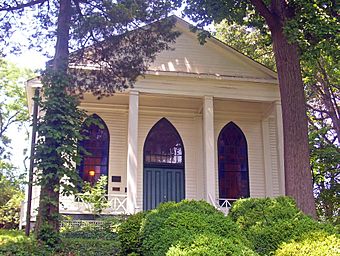Bethesda Meeting House facts for kids
Quick facts for kids |
|
|
Bethesda Meetinghouse
|
|

Front elevation, 2008
|
|
| Location | 9400 Wisconsin Ave., Bethesda, Maryland |
|---|---|
| Area | 0 acres (0 ha) |
| Architectural style | Greek Revival, Queen Anne |
| NRHP reference No. | 78003557 |
| Added to NRHP | July 17, 1978 |
The Bethesda Meeting House is a very old church building in Bethesda, Maryland. It is located in Montgomery County, Maryland, in the United States. This special building gave its name to the entire area around it back in the 1870s. It sits right on Maryland Route 355, which is also called Rockville Pike there. The Bethesda Meeting House has been recognized as a historic place since 1977.
Contents
What is the Bethesda Meeting House?
The Bethesda Meeting House property includes a few important parts. There is the main meeting house building, which was built in 1850. There is also a parsonage, which is a house where the church's minister used to live. This house was built in the mid-to-late 1800s. The property also has a cemetery, which is a burial ground.
A Look at the Building
The church building itself is quite large. It is made of wood and built in a style called Greek Revival architecture. This means it looks a bit like ancient Greek temples. However, its windows are in a different style called Gothic Revival architecture, which often features pointed arches.
The parsonage, or minister's house, is south of the church. It is a two-story wooden house built in the Victorian style. It has a special shape, like a cross, and some pretty decorations from the Queen Anne style.
The Story of the Meeting House
The current Bethesda Meeting House was built on the spot of an even older church. That first church, built in 1820, sadly burned down in 1849. The new building opened in 1850. It served as the Bethesda Presbyterian Church for many years.
In 1925, the church congregation moved to a new building. They built it farther south in Bethesda on Wilson Lane. When they moved, the old building and about 7 acres of land were sold to a woman named Mrs. May Fitch Kelley. However, the Presbyterian church kept ownership of the cemetery.
Mrs. Kelley lived in the old church building for a long time. Later, in 1945, the property was sold again. This time, it went to a group of Catholic missionaries from France and Algeria. They were known as the White Fathers. In the 1950s, the property changed hands one more time. It was then transferred to the trustees of the Temple Hill Baptist Church.
How Bethesda Got Its Name
The Bethesda Meeting House played a big part in how the town of Bethesda got its name. In the 1860s, the church's pastor, Reverend Edward Henry Cumpston, started asking the local postmaster, Robert Franck, to change the name of the post office. The post office was then called "Darcy's Store."
In 1871, the postmaster agreed and renamed the post office. The surrounding community then started using the name "Bethesda" as well. That's how this historic meeting house gave its name to the entire area!



